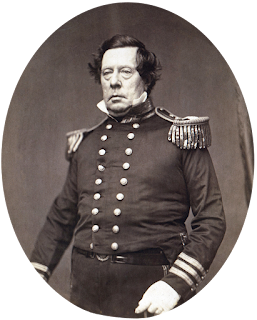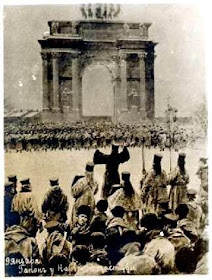At
2pm of October 6, 1973, while Israel observed Yom Kippur, Egyptian guns
bombarded Israeli forts along the Suez Canal, while the Syrians attacked Israeli
positions within the Golan Heights. The surprise attacks signaled the start of
the Arab-Israeli War known as the Yom Kippur War or Ramadan War in Arab states. But what led the two Arab
countries to attack Israel? What drove them into starting another
conflict in a highly volatile region?
Pages
▼
Monday, October 31, 2016
Saturday, October 1, 2016
Wednesday, August 31, 2016
Tuesday, August 16, 2016
Friday, August 12, 2016
Tuesday, July 26, 2016
Wednesday, July 20, 2016
Thursday, July 14, 2016
Wednesday, July 13, 2016
Monday, July 11, 2016
Documents in History: 1857 Additional Articles to the Treaty of Commerce between the Netherlands and Japan
 The Dutch, after Perry's departure, negotiated and signed a treaty in 1856 with the Japanese expanding its activities beyond Dejima and into the whole of Nagasaki. In 1857, Donker Curtius, head of the Dutch enclave negotiated additional articles that expanded further Dutch influence, including the addition of the status of most favored state. Explore the contents of this 1857 treaty bellow.
The Dutch, after Perry's departure, negotiated and signed a treaty in 1856 with the Japanese expanding its activities beyond Dejima and into the whole of Nagasaki. In 1857, Donker Curtius, head of the Dutch enclave negotiated additional articles that expanded further Dutch influence, including the addition of the status of most favored state. Explore the contents of this 1857 treaty bellow.Monday, July 4, 2016
Wednesday, June 29, 2016
Tuesday, June 28, 2016
Sunday, June 26, 2016
Friday, June 24, 2016
Thursday, June 23, 2016
The Bakumatsu (Part 6): Choshu Domain
Choshu
Domain violently closed the vital Shimonoseki Strait as a result of the Order to Expel the Barbarians. The Bakufu in Edo, meanwhile, took the
order more cautiously by choosing diplomacy to close the treaty ports. The order resulted to friction between the Sakoku and
the Kaikoku parties in the country.
Explore these shock waves that hit Japan.
Wednesday, June 22, 2016
Tuesday, June 21, 2016
Sunday, June 19, 2016
The Bakumatsu (Part 1): Opening of Japan
After
Perry and the Bakufu signed the Treaty of Kanagawa in March 1854, floodgates
opened to Japan for foreign countries to demand treaties giving Japanese a semi-colonial status. Explore the following events after the Treaty
of Kanagawa and rise in interaction with the so-called foreign
“barbarians.”
Monday, May 2, 2016
Saturday, April 30, 2016
Wednesday, March 23, 2016
Tuesday, March 22, 2016
The Russian Revolution of 1905 (Part 9)
With the economy ceased and people rallied in streets
against the Tsar and his autocratic powers, the Russian government faced
paralysis and tougher challenges. In face of this, the Tsar ultimately conceded
to reforms by signing the October Manifesto. Explore what were the contents of
the October Manifesto and its effect to the Revolution of 1905.
Monday, March 21, 2016
The Russian Revolution of 1905 (Part 8)
As the Russian Empire
plunged into anarchy, officials discussed measures to abate the situation,
including the need for reforms. But the Tsar hesitated for any reforms. Explore
how the government acted upon the proposed reforms that ultimately resulted to
the October Manifesto continuing crisis that shook the government.
Friday, March 18, 2016
Thursday, March 17, 2016
The Russian Revolution of 1905 (Part 6)
With reforms and freedom
constrained for decades, a war mishandled and a door opened for expression,
Russians cried for changes Russia’s autocratic rule. They demanded civil rights,
freedom, and social justice. But with a massacre in a cold January day, events
spiraled out of control resulting to the Revolution of 1905. Explore how the
event the 1905 Revolution transpired and brought the Tsardom went near the
brink.
Wednesday, March 16, 2016
The Russian Revolution of 1905 (Part 5)
 With the assignation
of Interior Minister Plehve, a new Interior Minister, Pyotr Sviatopolk-Mirsky,
relaxed controls against dissent. The relaxation resuscitated hopes of reforms.
The Tsar fueled further calls for reforms when he plunged the country into the
terrible Russo-Japanese War. Explore how the reformist movements restarted and
the factor of the Russo-Japanese War contributed to the Russian Revolution of
1905.
With the assignation
of Interior Minister Plehve, a new Interior Minister, Pyotr Sviatopolk-Mirsky,
relaxed controls against dissent. The relaxation resuscitated hopes of reforms.
The Tsar fueled further calls for reforms when he plunged the country into the
terrible Russo-Japanese War. Explore how the reformist movements restarted and
the factor of the Russo-Japanese War contributed to the Russian Revolution of
1905.Tuesday, March 15, 2016
The Russian Revolution of 1905 (Part 4)
Sentiments towards
reforms and nationalism as embodied by parties and nourished by new political
ideologies. Various parties then took root and nourish to various institution
where Russians meet, talk, and see the wrongs in Russia. But the government
continued to be oblivious to change and continued to repress signs of them.
Explore how various institutions played a role in spreading the spirit of
reforms amongst Russian and how the government acted to subdue them before the
Revolution of 1905.
Monday, March 14, 2016
The Russian Revolution of 1905 (Part 3)
The Russian heartland
saw the rise of various political parties embodying different ideologies and
aspirations of the people. But besides the Russian, non-Russian minorities
under the Empire also forged their own political parties. Explore these
political parties in the satellite territories of the Russian Empire.
Sunday, March 13, 2016
The Russian Revolution of 1905 (Part 2)
Russia’s course in
the last 50 years of the 19th century saw changes in policies, society, and
economy. The situations created new challenges and aspirations. With infusion
of new ideologies, it led to the creation of political movements and parties.
Explore what were the ideologies that spread and political parties that
emerged, which played key roles in the Russian Revolution of 1905.















































